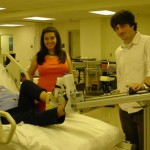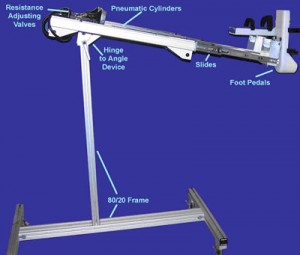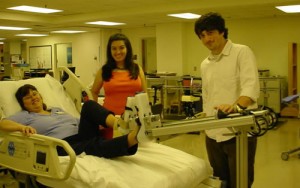Designers: Joy Kasaaian and Sevan Abashian
Client Coordinators: Anne Kelly OTR/L and Pat Cox PT, Duke University Medical Center
INTRODUCTION
Individuals in the intensive care unit may have to stay in bed for extended periods of time (weeks or more). As a result, their legs become weak and it is difficult to transition them to a standard hospital room when their medical condition has improved. A lack of leg movement can also lead to muscular atrophy and low blood flow in their lower extremities. To address these problems, we developed a Supine Leg Exerciser, which provides a way for patients to exercise from their hospital bed.
SUMMARY OF IMPACT
The client coordinators said that “it is very difficult to aerobically condition patients [who are confined to a hospital bed for extended periods], due to the tubes, multiple IVs, etc. We requested a device that allows us to strengthen and aerobically condition the patient who is debilitated and limited to bedrest. This device also needs to be portable for ICU nurses to manage safely in patient rooms. The Supine Leg Exerciser appears to meet these requirements! We are currently performing trials using the device on patients. The impact we are looking for is a decreased length of stay, decreased time on the ventilator, and increased functional and aerobic capacity.”
TECHNICAL DESCRIPTION
Figures 1 and 2 show photos of the device. The hospital staff positions the device at the foot of the bed and places the user’s feet in the pedals. The user can then move their feet back and forth, independently, and the pedals slide along a track. As the user gains strength in their legs, the staff can also adjust a valve to provide resistance to movement. The hospital staff can easily clean the entire device before using it with a new patient.
The device is composed of two tracks, with pedals that glide along them. Each pedal has a heel cup for support. Inside of each track is a pneumatic cylinder that is connected to a series of valves to provide adjustable resistance. The tracks sit upon a wheeled aluminum frame. The patient will be able to make a flexion/extension motion along the tracks that will provide a low resistance aerobic exercise to help build leg muscle.
The frame is three feet tall and on wheels, so that the hospital staff can easily move it. It is constructed of T slotted framing aluminum (8020, Columbia City IN). The horizontal portion of the frame can be adjusted to any angle from 0 (horizontal) to 90 degrees (vertical for storage). Typically, a 15-30 degree angle with the bed is optimal, in order to utilize gravity to help the patient pull back on the pedals. There are two sets of 20 inch drawer slides that are connected to the frame, and they are rated at 100 lbs/pair. The gliders made of a rectangular aluminum tube with ¼” wall thickness. Two rods protrude from the glider box, and they have another rod going across them, which connect the bottom of pedal to the glider. The pedals were created in Duke Orthotics lab using molded Kydex.
A bicycle pump provides resistance that the user must push against. The pumps are connected to the back side of the gliders, with the pump’s “handle” section facing the patient, and the air hose facing away. This air hose is connected to a series of valves that will allow a hospital staff person to adjust the amount of pressure that the patient pushes against. When the valve is all the way open, there is very little resistance. The device also includes a pair of counters so that clinicians can keep track of the number of repetitions. They are triggered mechanically when the user completely extends their leg. The pedal has slots for Velcro straps and a heel cup.
In total, the device costs about $600.




University Operator: (919) 962-2211 | © 2024 The University of North Carolina at Chapel Hill |